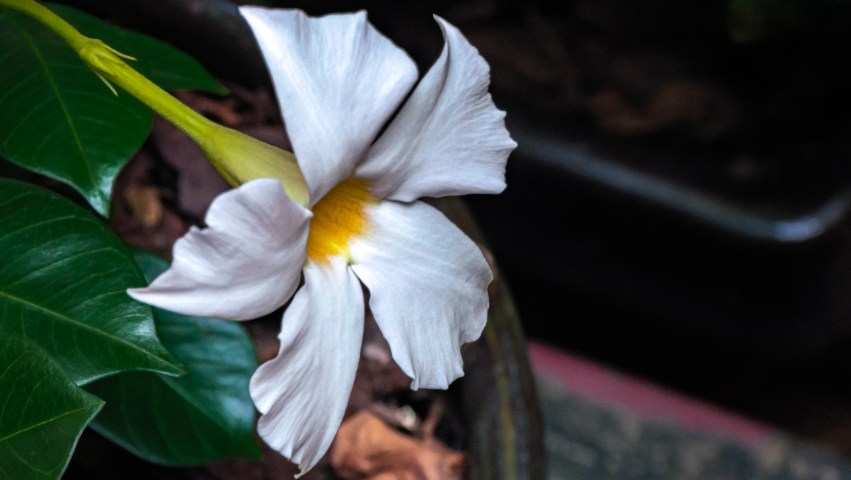From “Magdalen Walks” by Oscar Wilde in The RHS Book of Garden Verse by the Royal Horticultural Society:
See! the lark starts up from his bed in the meadow there,
Breaking the gossamer threads and the nets of dew,
And flashing adown the river, a flame of blue!
The kingfisher flies like an arrow, and wounds the air.
And the sense of my life is sweet!
though I know that the end is nigh:
For the ruin and rain of winter will shortly come,
The lily will lose its gold, and the chestnut-bloom
In billows of red and white on the grass will lie.
And even the light of the sun will fade at the last,
And the leaves will fall, and the birds will hasten away,
And I will be left in the snow of a flowerless day….
Hello!
This is the third of three posts featuring dipladenia flowers from my garden. The first post is Do You Know Dipladenia? (1 of 3); and the second post is Do You Know Dipladenia? (2 of 3). For this post, I took a few of the photos from the previous two, twisted them into slightly different crop formations, then painted the backgrounds black.
This post marks the last of my spring and summer photographs for 2022 — about 240 photos from my gardens, and about 480 from my ‘hood (mostly Oakland Cemetery’s gardens but also Grant Park’s Grant Park). Since I use Lightroom to organize my photo projects — and separate the projects by year and season — I thought it was fun to compare this year to last year, and found that I posted almost (within 10 percent of) the same number of photos as 2021. Weird, that, because in my imagination I thought I had posted a lot less this year… but I guess not! I’m blogging at a pace of six to eight posts a month — each with new photographs and many with new writing — which seems to keep me at a reasonable balance between maintaining a site and regular life.
A heightened level of new fall color has blanketed my city over the past couple of weeks, presenting between bouts of rain when the sun comes out. While some of the first-turning, more boring leaves had hit the ground early, Japanese and other maples in particular are just now absolutely glowing in red, orange, and yellow — waiting patiently for someone’s (I wonder whose!) camera. Late season flower-bloomers like mums, daisies, coneflowers, goldenrod, and anemone, however, have recently been photographed and are in my “to be processed” Lightroom collections. My back yard is covered with discarded oak leaves from my neighbor’s tree to the height of the dog’s knees, demanding (but not yet getting any) attention. At the same time — with Thanksgiving under our belts (so to speak!) — the boxes of Christmas decorations have been dragged from their oh-so-tight storage spaces and are strewn about the house in various states of disorganization. Is this what multitasking is supposed to be for? I always thought that concept was strange; I mean: isn’t it true that only one thing gets done at a time? Those decorations — as I write this — aren’t putting up themselves!
I treated myself to a second Christmas tree for my home office this year — a six-foot slim or pencil tree, as they’re often called — and stood it up a couple of weeks ago shortly after it was delivered (I couldn’t resist!), then festooned it with a few hundred multicolored lights and a delightful batch of red, green, and gold shatterproof ornaments. The Dog — or The Photographer on his behalf — is a big fan of shatterproof ornaments because one of us likes to walk by the tree and bat at the low-hanging glitterlicious objects with his paw. For some reason he believes that’s forbidden, even though I’ve never reacted or tried to correct him for doing it. Funny how they know such things, isn’t it?
I often see him out of the corner of my eye when I’m at my desk as he does this: he sneaks forward one step at a time, checks to see if I’m looking, takes another step or two until an ornament’s within reach, checks on me again and if I don’t make direct eye contact taps it with his paw to get it swaying… then rests on his haunches to marvel at the motion he’s made. I’ve tried to take a few photos to catch the little elf in action — but me picking up the camera he thinks is a signal we’re going outside, so he races to the back door before I can get the shot. Ah, well, we’ll keep trying; and since we bought the tree so we’d have something new to photograph (and play with!), we may still manage a shot of the pup pawing its decorations over the holidays.
(Haha! True story: as I was proofreading this post, he tried it again: snuck up to the tree and glanced toward me, but I looked right back at him and I swear he pulled a guilty face then ran into the kitchen for a drink of water. Dog-crime makes a canine very thirsty, apparently!)
Thanks for reading and taking a look!













































































